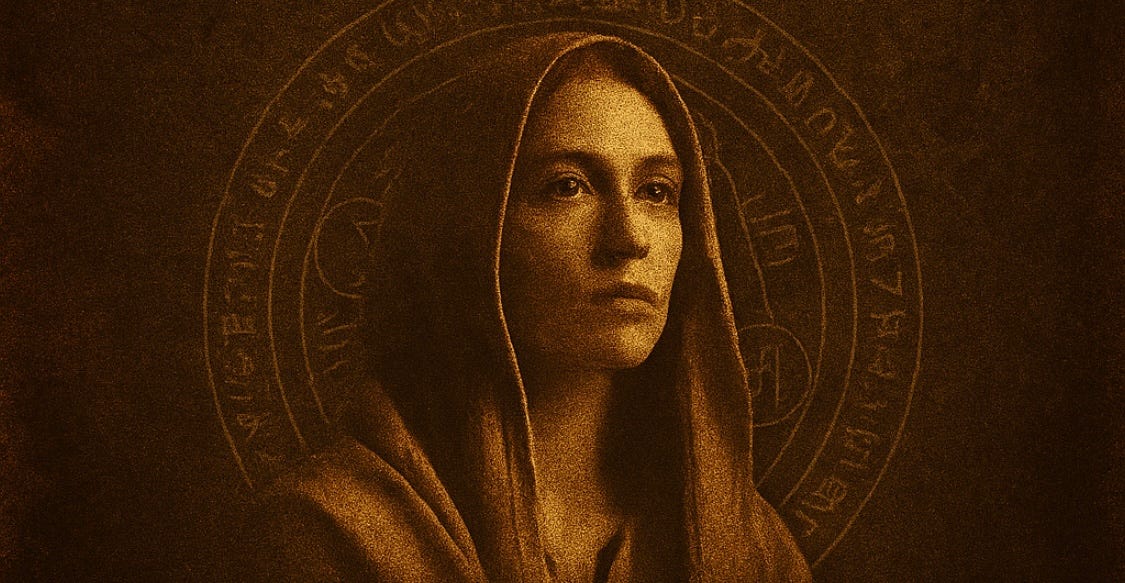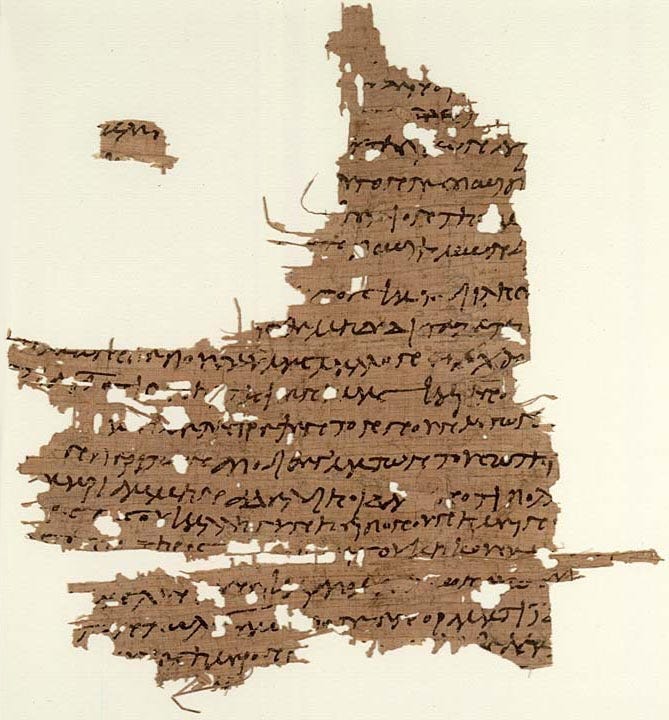The Stories That Were Too Dangerous to Survive, Part 1: The Gospel of Mary Magdalene
The woman with a million faces.
History isn’t just written by the victors—it’s edited, redacted, and censored by them too. Some stories weren’t forgotten. They were erased. And this? This is one of them.
Mary Magdalene. A figure coloured in every shade history could throw at her. Was she a prostitute? A disciple? Christ’s wife? The true leader of the early Church? Take your pick—conspiracy or revelation, depending on your lens.
Her story has echoed through pop culture, art, and literature. From The Da Vinci Code to The Last Temptation of Christ, she’s been romanticised, vilified, sanctified—and almost always misunderstood.
But who was she really? And more importantly—what did her Gospel say that made the Church so eager to bury it?
Let’s take a look.
In 1896, a manuscript turned up in Egypt. Papyrus, Coptic, ancient book stuff—you get the gist. It ended up in a museum in Berlin. Inside was The Gospel of Mary. Pages were missing (coincidence?), but what remained was… unexpected.
The gospel reads nothing like the ones we know. It’s not a retelling of Jesus’ life. It’s more like a philosophical dialogue—part mystical text, part spiritual manifesto. And Mary isn’t just in it. She’s at the center.
Let’s break down the six key moments. Because, well… they hit hard.
1. The “Sin” Plot Twist
“The Savior said: There is no such thing as sin. You create sin when you act in accordance with the nature of adultery, which is called sin.”
Meaning: According to this gospel, sin isn’t real. It’s not an inherent moral failure—it’s a construct. A control mechanism. Not divine law, but human invention. (Feeling uncomfortable yet?)
2. Mary: Not Just Another Disciple
Peter said to her: “Sister, we know the Savior loved you more than the rest of the women. Tell us the words he shared with you—the ones we don’t know.”
Meaning: Even Peter admits Mary had a deeper connection to Jesus than the rest. She wasn’t just part of the group. She was entrusted with teachings the others didn’t hear. That says a lot. And it also explains a lot—like why her gospel never made the cut.
3. The Soul’s Escape from Desire
Desire: “I didn’t see you descend, but now I see you rising. Why do you lie? You belong to me.”
The Soul: “I saw you. But you didn’t see me. I wore you like a garment, and you didn’t recognize me.”
Meaning: The soul escapes the grip of Desire (material existence) through knowledge. This salvation doesn’t come from priests or dogma—it comes from within. Think Platonic Forms meets Gnostic mysticism, with a dash of Hindu Brahman.
4. Mary Holds the Group Together
“Do not weep. Do not grieve. Do not let your hearts be troubled. His grace will be with you and protect you.”
Meaning: After Jesus departs, it’s Mary—not Peter—who holds the group together. She becomes the emotional and spiritual anchor. Leadership in the hands of a woman? Paging Dan Brown…
5. The Confrontation with Peter
Peter: “Did the Lord really speak privately with a woman and not us? Are we supposed to believe her?”
Levi: “If the Savior made her worthy, who are you to reject her?”
Meaning: Peter is clearly uncomfortable with a woman holding authority. Levi calls him out. The tension is obvious. And kind of timeless, honestly. These early cracks in power dynamics tell you everything about what came next.
6. God Is Within
“Every nature, every form, every creature exists within and alongside one another.”
Meaning: We’re all connected. God isn’t “out there”—God is within. A mystical, almost pantheistic worldview, closer to Plato, Spinoza, or Buddhist thought than to traditional Christian teachings.
This gospel doesn’t just offer a different perspective. It offers dangerous freedom.
It threatens the carefully curated doctrine built by Church councils, who selected texts with surgical precision, keeping what fit their narrative and discarding what didn’t.
And sure, someone might say: “But what if Mary was just delusional?”
Well… what if any of them were? Ever noticed how the Synoptic Gospels (Matthew, Mark, Luke) read like slightly reworded copies of each other, as if someone was tweaking the script? And then John swoops in, declaring himself “the beloved disciple,” crafting a whole new vibe—but still playing along with the same central storyline.
But Mary’s gospel? It stands apart. And the kicker? Other texts back her up.
The Gospel of Philip calls her Jesus’ koinonos—his companion—and claims “the Lord used to kiss her often on the mouth.”
The Gospel of Thomas paints her as the most spiritually advanced disciple.
So no, this isn’t just one rogue gospel—it’s a buried tradition.
And if that’s not enough, let’s talk about the Church’s obsession with discrediting her.
In the 6th century, Pope Gregory the Great conveniently fused Mary Magdalene with the anonymous “sinful woman” in the Gospel of Luke. Zero biblical evidence. Total smear campaign.
Why? Because they knew about the apocryphal gospels. And they needed to shrink her down—from spiritual leader to redeemed prostitute. Keep the symbol, erase the threat.
There was already an underground movement seeing Mary as a vessel of sacred, esoteric knowledge—especially among Gnostic Christians. And the Church had to crush it.
How? Easy: turn her into a former harlot “saved by grace.” Keep the name, rewrite the meaning. Problem solved.
They saw the storm coming. And they chose to destroy her.
Fast forward to 2016—only took 1,400 years—and the Vatican finally says, “Oops, our bad,” and gives her the title Apostle of the Apostles.
Gee, thanks. Right on time.
The Church knew about these gospels. They saw their influence.
So what did they do?
They were declared heresy and systematically erased. Not because they were fake—but because they were too real. And in 1945, Nag Hammadi reminded the world they never really disappeared.
The Church didn’t forget them. It made a conscious editorial decision. They chose what would be “true.” They invented canon.
So yes—they knew.
And they were terrified.
Why? Simple.
If sin isn’t real, how do you control people through guilt?
If salvation isn’t about obeying rules and rituals but about inner knowledge—what’s the Church’s job then?
If the soul finds freedom through understanding, not punishment—why would you need priests, confession, or indulgences?
And what about all those “blessed are the meek,” “don’t ask questions,” “just obey and wait for your reward in heaven” slogans? Don’t challenge authority. Don’t think too much. Don’t read certain books. Knowledge is fine—as long as it’s Christian-canon knowledge.
Yeah… you see where this was heading, right? That could’ve been the end of religious power structures as we know them.
If Peter wasn’t the chosen one—but Mary was? Then maybe the Pope isn’t the heir.
And if Mary—a woman—was the true leader? Then maybe women aren’t just sweet mothers like the Virgin Mary. Maybe they’re more. Maybe they’re spiritual leaders. World-shattering, right?
And if God is within us, and we are gods—
Then God isn’t some distant, untouchable being.
And if we’re not sinners, then why do we need “guidance”? Why the confession booths? Why the holy guilt-trips?
Great business model though—fear and guilt. Very profitable.
Oh, and let’s not forget the kissing.
Was Mary Jesus’ wife? Did Jesus have feelings? Weaknesses?
Was he… human?
That’s a lot to unpack.
But this is where we stop.
Because nothing here is certain. Not really.
These are thoughts, interpretations, possibilities—not truths carved in stone.
And if Mary was right—if the point of all this is deep understanding, inner knowledge, and a soul that frees itself from the material world—
then I can’t lead you there.
Nor should I.
If that’s the purpose, then the rest is yours
Your freedom to think, to question, to search.
Claim it.
If you made it to the end—well, thank you! Clearly, we have a lot to discuss. Drop whatever pops into your mind in the comments. If you enjoyed this, stick around for more every Wednesday. And if you really enjoyed it, share it with someone who loves stories and help grow our little corner of storytelling chaos.
And hey, If you’re into these deep dives, you can help keep the popcorn flowing on Ko-Fi! 🍿






There is no reason to think the Gospel of Mary is "real" in any meaningful sense. It postdates the Gospels by centuries and the texts you cite as in agreement with it are also from centuries later. The Gospel of Thomas may be from earlier but it was always universally rejected as spurious.
"Ever noticed how the Synoptic Gospels (Matthew, Mark, Luke) read like slightly reworded copies of each other, as if someone was tweaking the script?" Yes, literally every person who has ever read the Gospels has noticed this.
Perhaps St. Gregory conflates too many figures in his depiction of Mary Magdalene, but this is not to deprecate her at all. He identifies her not just with the repentant woman of Luke 7 (and by the way, this description immediately precedes the identification of Mary Magdalene as the one from whom seven demons were expelled; and so this has been read as a subtle identification), but also with the Mary, the sister of Martha. In this, he praises her as the icon of the contemplative life, the one who "has chosen the better part, which shall not be taken from her," and the one who "has done an excellent thing for me" and which will be told "in memory of her." She is called "Apostle of the Apostles" by the greatest teachers of the Middle Ages. This is not a concession to some Gnostic forgery.
Sorry, but I hate this sort of fiction that pretends to uncover the "true meaning" of the Gospel, when it's really just pandering to personal biases. "Oh wow, what if really it's okay to sin, and the Church covered it up." Please. Just go sin if you must, but do not justify it by recounting false stories about the Lord and his saints.
Furthermore, the points you make that are actually true are not earth-shattering. Peter acting like a buffoon?! That happens every other page in the canonical Gospels. Women having a better grasp of the Gospel than the disciples? Of course. They were the ones that remained at the Cross. While the disciples get uncomfortable at any mention of death, Martha gets a wonderful profession of faith in John 12: "Yes, Lord; I believe that you are the Christ, the Son of God, he who is coming into the world." These are important themes of the actual Gospels.
Dangerous freedom? Please. Yes, it is very interesting as a document showing what a 3rd century sect may have believed. There are indeed echoes of an authentic tradition. But to claim such writings as equal or superior to the Gospels as records of fact is embarrassing at best.
That's a good piece!
I was lucky enough to go see the Gospel of Thomas years ago, either in 2005 or 2006, when it was on display at the National Geography facility in Washington, D.C. While I am not a religious person, the woman I was dating at the time was, and I thought it would be significant enough to take her to, while there was the opportunity.
There was some debate at the time because of what was recorded related to Mary's place in the congregation of Jesus, and this article explores that debate very well.
I guess being middle-aged does carry some benefits after all (along with all the disadvantages) in that I've seen and done some things!
Thank you, Olga, for putting this together. It's an interesting read, and you did a great job.
I would encourage everyone to learn history and its context because deliberate omissions can have devastating impacts on context.